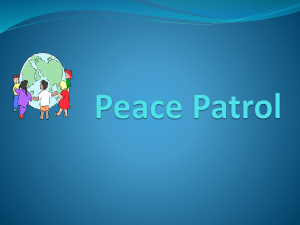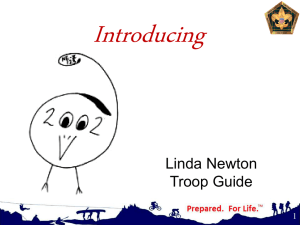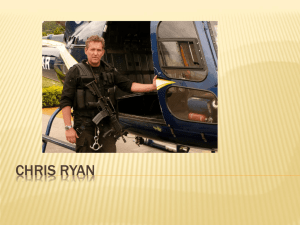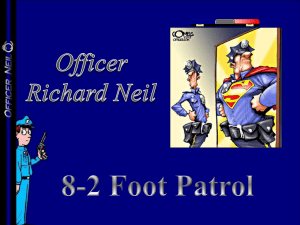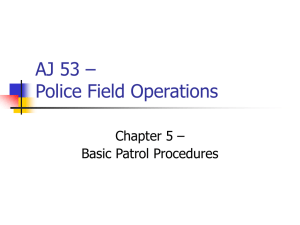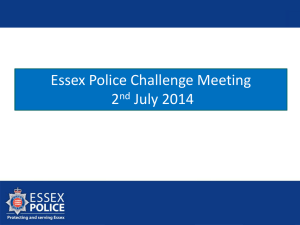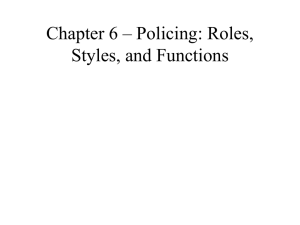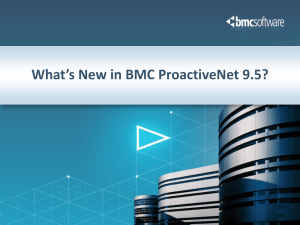AJ 53 – Police Field Operations - Sierra College Administration of
advertisement
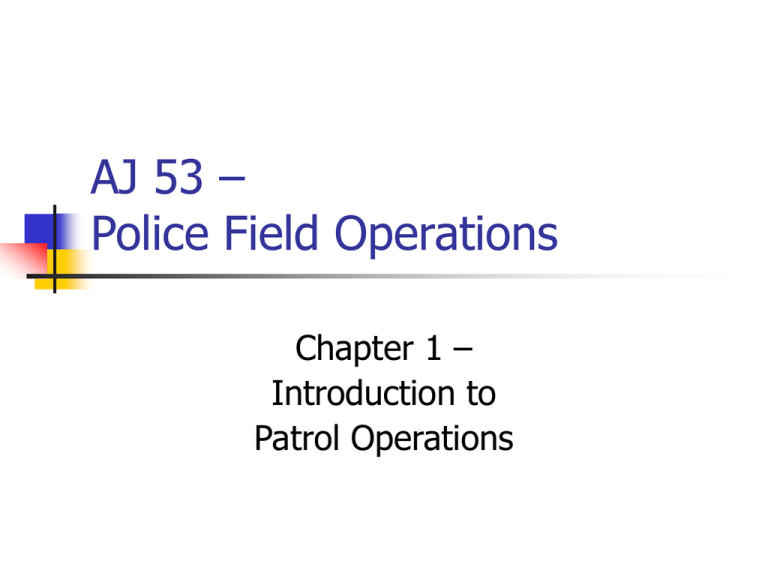
AJ 53 – Police Field Operations Chapter 1 – Introduction to Patrol Operations Patrol Roles and Responsibilities Roles Government agent Crime Fighter Mediator Problem Solver Investigator Jailer Parent Social Worker Responsibilities Uniformed Visibility Public Accessibility Law Enforcement Community Policing Crime Prevention Crime Suppression Public Information Assist Prosecution Evolution of Patrol Patrol derives from Patrouiller (French) “ to tramp around in the mud” Literally – making regular, repeated circuits of an area to guard or inspect Early America Night watchmen on “patrol” Sometimes volunteers or those being punished Eventually became paid, professional, government employees Professional Era of Law Enforcement (1940’s & 1950’s) Reforms due to earlier days of corruption Many cops were military veterans White male dominance Lack of gender/cultural diversity Efforts to professionalize Higher education encouraged Pre-employment testing Academy training “To Protect and Serve” Primary goals of Law Enforcement Reactive Traditional mode of responding to calls for service “after the fact” Take report, investigate, and arrest Proactive Community Policing, Problem-Solving, etc. Cooperation + Communication = Trust Reduce crime & fear of crime Participative Law Enforcement How did people “police” themselves before the days of modern Law Enforcement? How does the local police/sheriff’s department make sure people feel safe? Public Safety is the mutual responsibility of both the Police and the Community! Cooperation and Communication Crime Prevention Why do people commit crime? How does Law Enforcement try to prevent crime from occurring? What are some of the barriers to preventing crime from occurring? Reduce desire Increase cost/risk Rehabilitation How do you measure success of crimeprevention programs? Crime Repression Repression = reduction or elimination of opportunity to commit crime Uniformed patrol, security officers Foot patrols, PR contacts, Field Interviews In-store anti-theft devices Video surveillance Lighting Success relies on public’s fear of being caught and punished Elements of Identification, Apprehension, and Prosecution Knowledge of criminal law Quick response Control scene Initiate investigation Communication skills Penal Code sections Elements of crimes Laws of Arrest, Terry, Miranda, etc. Build trust and cooperation Interviewing, information gathering Evidence collection Future use in court Traffic Flow and Collision Reduction Collision-free traffic flow = safety! Vehicles and pedestrians Police identify causes of congestion and methods to reduce it through… Enforcement Engineering Which violations? Where? When? Patrol officers provide valuable input Education Citation? Warning? Lecture? Keeping the Peace 830.1 PC defines cops as… Peace Officers!!! Majority of patrol time spent on noncriminal activities Keeping the Peace Civil matters PR contacts Lost & Found Community Service Crisis Planning and Emergency Preparedness Ever alert for any emergency Natural disasters Major incidents Earthquakes, fires, storms, floods, etc. Airplane/Train crashes, Chemical spills, Riots, etc. State and Departmental policy will assist with proper response SEMS, update training “Routine” Patrol What is “Patrol”? Moving around within a designated beat/area of responsibility during a certain timeframe Beat Integrity Vehicle, foot, bicycle, horse, etc. Day-shift, Swing-shift, Nights/Graveyards Accepting accountability for what occurs in your beat Why should you vary your patrol “routine”? Advantages of random, proactive patrol? Public Gatherings Parades, Celebrations, Rallies, Protests… Why does Law Enforcement provide a visible, uniformed presence at large public gatherings? Maintain peace and order Create feeling of safety Immediate response for law violators Riot prevention better than control! Public Servants Community Policing Programs Business Security Fires, downed wires, traffic hazards, etc. Public Outreach Maintain open communication with business owners in your beat Hazardous Conditions PR contacts, crime-prevention tips, etc. Neighborhood meetings, school presentations Tour Guide Directions, available services, etc. Calls For Service Many are not crime-related! Neighborhood disputes Landlord-tenant disputes Repossessions Child-custody issues Many result in referrals to other public agencies Small-claims court Better Business Bureau Animal Control Traffic Control and Enforcement What are a patrol officer’s responsibilities for enforcing traffic laws? Public safety Collision prevention Generate revenue How does an officer decide what areas to focus on during patrol shift? Minor violations Parking DUI Specific locations Developing Positive Contacts Good cops build positive relationships with people… How? Victims, witnesses, suspects, etc. Benefits may return down the road Treat everyone with due respect Cultivating informants Motivation? Integrity? Honesty? Reliability? Preliminary Investigations Responsibilities upon arrival at crime scene, traffic accident, suspicious circumstances, etc. Personal safety Protection and control of the scene Dispatch, other officers, supervisor Interviews & Note Taking Suspects, weapons, evidence Communication Officer, victim, witnesses First-aid, ambulance, etc. Victim/witness statements Report Writing Evidence Evidence is key to successful prosecution! Identifying Photographing, Sketching/Drawing Before anything moved or disturbed Collecting What is possible evidence? Proper handling, packaging Minimize contamination for future testing Chain-of-Custody must be maintained! Arresting Offenders Suspects usually gone before you arrive, but if still present… Reasonable Suspicion to Detain? Probable Cause to Arrest? Pat-down for weapons only (Terry vs. Ohio) Misdemeanor? Felony? Private-Person’s Arrest? Miranda? Booking at County Jail Bail? Release on Own Recognizance (OR)? Report Writing Crucial part of officer’s responsibilities Largely overlooked by media Majority of shift may be spent “writing paper” Reports must be… Clear, Concise, Thorough! Factual Accurate Objective Facts vs. Opinions Basis for future testimony Deployment of Personnel Department managers (Chief, Sheriff, etc.) decide how to deploy personnel efficiently Refer to factors listed on pages 34-40 Other considerations… Rotation of assignments Shift work Permanent or temporary? 5-8’s, 4-10’s, 3-12’s? Promotions Experience level may diminish Proactive vs. Reactive Patrol Is random patrol effective? Why or why not? What should happen between calls for service? Traditional Policing Respond, investigate, arrest, repeat Community Policing Initiate positive contacts, communicate, build trust and cooperation with community members Discretionary Decision Making Discretion = The ability to exercise freedom of choice in daily activity and decisions How does this connect to Patrol work? What factors guide an individual officer’s discretionary decision making? Statutory and Case Laws Department Policy Personal Biases and Prejudices Ethics and Integrity Part of Professional Organizations Medicine = Hippocratic Oath (400 BC) ABA = Rules of Professional Conduct Law Enforcement Code of Ethics Adopted in 1956 by IACP Taken as oath by all Calif. Peace Officers Useless unless put into practice Must be genuinely believed in/adhered to Should be displayed by all within the profession Civil and Criminal Liability Civil Liability = financial responsibility for damages caused by officer/department Common reasons for lawsuits against individual officers and their departments False arrest/imprisonment Excessive force Violation of constitutional rights Racial Profiling Criminal Liability = criminal charges filed against officers for illegal conduct Peace Officers’ Bill of Rights Enacted by CA Legislature, 1980 Procedural protections for officers facing potentially punitive actions Reasonable interrogation Notified of charges Access to interview tapes No forced polygraph Time to respond in writing

